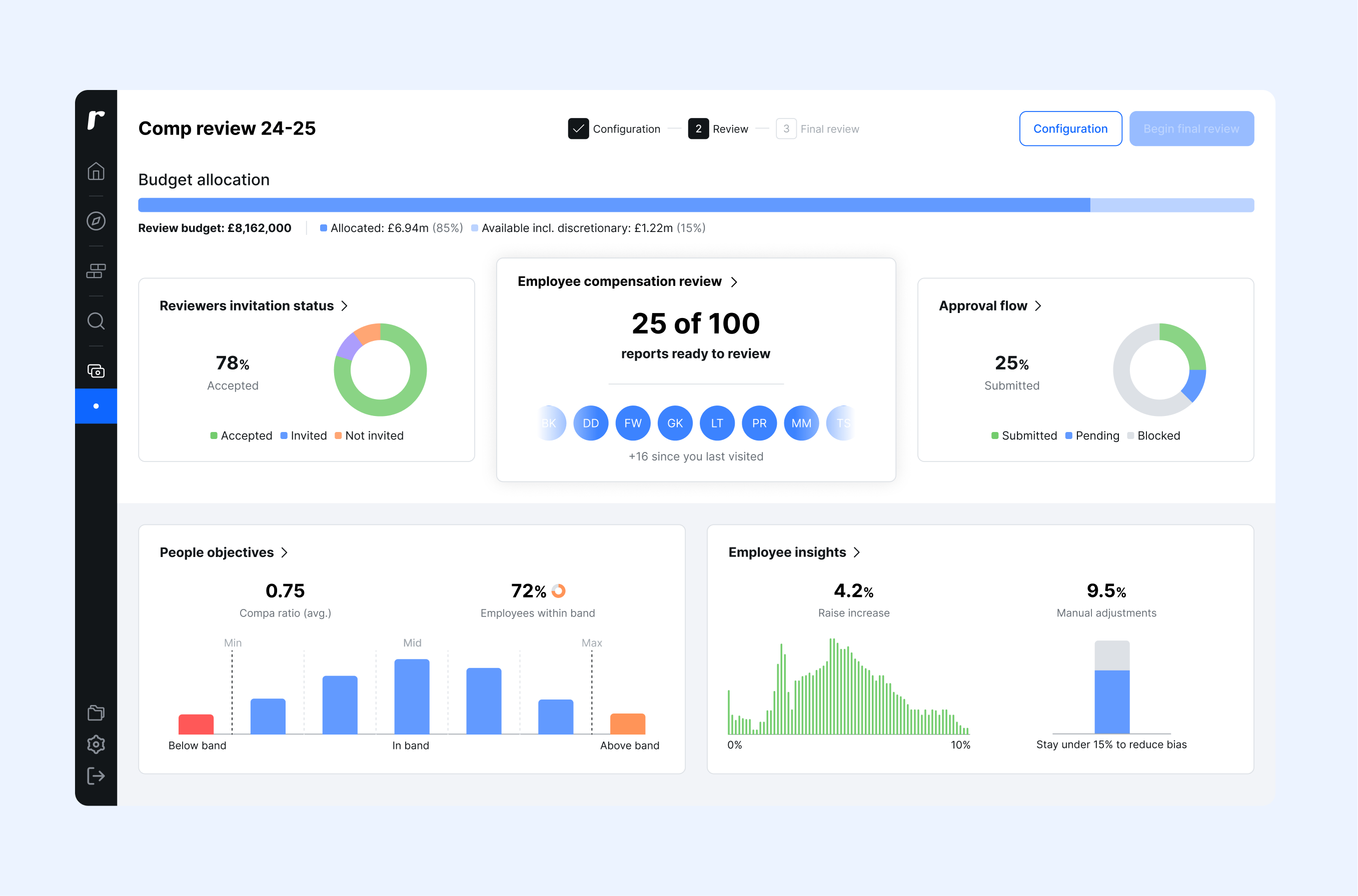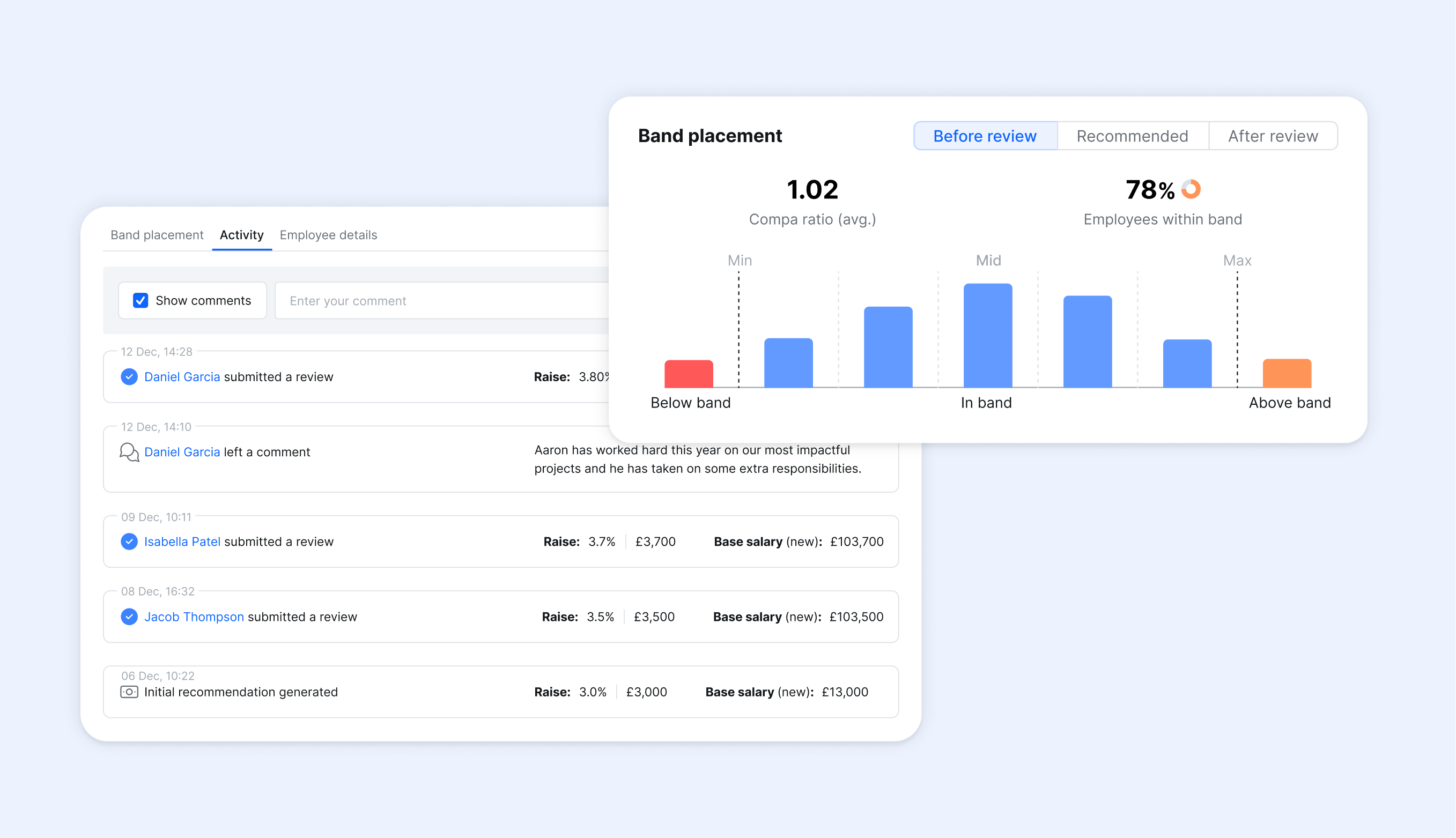Despite the complexity and importance of pay reviews, our research found that 54% of companies still rely on spreadsheets to manage the process.
It's understandable – spreadsheets feel familiar, they’re free to use, and many People and Reward teams have invested a lot of time into building impressive systems using them over the years.
But, Ravio’s pay review research also identified that companies who rate their process as highly effective (4-5/5) are significantly more likely to use compensation software rather than spreadsheets.
And there's a clear inflection point too – once companies reach 500 employees, only 23% still use spreadsheets to run pay reviews.
Why? Because beneath the surface of those familiar cells and formulas lie three hidden costs that compound with every review cycle to cause errors, inconsistencies, and inequities.
Cost #1: Controlling access – manual errors, version control chaos, and data privacy risks
Pay reviews are complex projects, and teams are navigating all the moving parts across multiple spreadsheets or spreadsheet tabs – one for current salaries, another for performance ratings, a third for tracking targets and bonuses, a fourth for manager recommendations, and yet another for budget calculations.
In many cases, each file also has multiple versions floating around ("Final_v3_ACTUAL_final.xlsx" sound familiar?), and you're left hoping that all stakeholders are working from the right file.
As one Reward Leader put it in our pay review survey: “We’re moving data across lots of spreadsheets, and we have other stakeholders like managers inputting information – there’s no unified view, and there’s lots of room for human errors to arise without us noticing.”

The impact
Issues with version control and human error leave costly mistakes waiting to happen:
- Pay errors that damage trust: One broken formula, misplaced decimal, or accidental cell delete can lead to incorrect pay adjustments. Explaining to an employee why their raise was calculated incorrectly isn't just awkward – it erodes trust in the entire process.
- Audit nightmares: When finance or leadership asks how a specific decision was made, tracking down the right version of the right spreadsheet becomes an archaeological dig through email attachments and shared drives.
- Data privacy risks: Having multiple versions of a spreadsheet that contains salary and performance information being shared is a legal risk waiting to happen – it wouldn’t take much for data to be shared where it shouldn’t. Employee salary data is personal data and is protected under data privacy laws like GDPR, sharing it illegitimately is illegal.
How pay review software solves it
Modern compensation review platforms eliminate the chaos by bringing all your pay review components into one unified system.
There’s no more juggling between files – everything lives in a single, streamlined platform where managers, HR, and finance all work from the same source of truth.
The best platforms go beyond basic consolidation.
Ravio, for instance, automatically brings live employee compensation data (from your HRIS) together with our real-time market data, existing salary band positions, merit matrices, pay equity analysis, budgeting, and approval workflows — all in one place.
Configure your review once: select eligible employees, set budgets, define your merit matrix and recommendation logic, and customise approval flows. Then let consistency define your process, with built-in guardrails guiding your team towards fair, defensible decisions.
Cost #2: Disconnected data and outdated benchmarks
Before every compensation review, it’s crucial to refresh your benchmarking data to inform the market-based adjustments that ensure pay stays competitive.
Traditionally, this has meant purchasing new survey data, manually updating benchmark spreadsheets and salary band ranges, and checking where every employee sits against the current market.
The process is painfully disconnected. Your employee data lives in one spreadsheet, market benchmarks in another, and salary bands in a third (and that’s before you even get to your comp review spreadsheets).
As one frustrated People Leader shared in our survey: "Our compensation reviews are based on old data, because Radford’s database tells me the survey results from last year, not what’s happening right now. We desperately need better projections or constantly updated benchmarks.”
The impact
Running pay reviews without integrated, current market data creates serious risks:
- Market misalignment: Without visibility into real-time market movements, the pay adjustments you define could still leave employees paid below market rates – which brings with it retention risks.
- Time-consuming manual changes: Manually updating benchmarks and bands, and calculating market adjustments for each employee takes a considerable amount of time for the People Team, and can easily lead to errors and inconsistencies too.
How pay review software solves it
The best modern compensation review tools eliminate the need for manual benchmark updates by providing continuously refreshed market intelligence.
In Ravio, for instance, as you configure your pay review, you can instantly refresh your salary bands based on current market benchmarks, seeing exactly how the market has moved since your last cycle.
During the review itself, managers see each employee's position against live market benchmarks, making it simple to include appropriate market adjustments.
With data updated continuously from over 1,400 tech companies, you're always working with current intelligence rather than last year's survey results.
Cost #3: Process inefficiency and lost productivity
Spreadsheet-based reviews create a lot of manual effort and inefficiency.
HR and Reward teams spend weeks on setup – consolidating employee data from multiple sources, updating formulas, building merit matrices, creating budget trackers, and preparing individual manager spreadsheets.
Then, during the review process itself, there’s all the stakeholder management: back-and-forth emails, chasing down late submissions, and manually checking that manager recommendations align with budgets and guidelines.
Each round takes days, and any change to approach, budget, or eligibility triggers the house of cards to come tumbling down – and the entire cycle have to be started again.
The feedback from our pay review survey was clear – with repeated references of struggles with “process effectiveness’ and “streamlining the process”. As one respondent put it: “One area that needs improvement is the automation of compensation processes. A lot of the work (like data consolidation, analysis, and decision-making) is still done manually, which slows things down and increases the risk of errors.”
The impact
This manual process creates cascading inefficiencies:
- An incredibly lengthy process: Pay reviews are already lengthy processes with many moving parts, but the manual nature of many of the elements makes it take much longer than it needs to – meaning HR and Reward teams must down tools on all other projects for the duration.
- HR burnout: Reward teams become spreadsheet administrators rather than strategic partners, drowning in version control instead of focusing on pay philosophy.
- Manager frustration: Managers struggle with complex spreadsheets they use once a year – and without integrated visibility into budgets or band positions, they're left guessing whether their recommendations are appropriate.
How pay review software solves it
Purpose-built compensation review software transforms chaotic coordination into smooth workflows with built-in collaboration and automation.
The best platforms provide intuitive interfaces that guide managers through the review process with all the market context laid out for them, whilst maintaining control for HR teams.
Ravio, for instance, gives managers the context and guidance they need to make better recommendations – they see each employee's position within their salary band, how that aligns with the latest market benchmarks, the employee’s performance rating, and the Reward team’s recommended increase based on a company-tailored merit matrix.
Built-in budget controls prevent overspending whilst customisable approval workflows route decisions to the right stakeholders automatically – with comment history enabling seamless collaboration without email chains or file sharing.
What to expect when you make the switch from spreadsheets to compensation software
Moving from spreadsheets to pay review software might feel daunting, but the transition is smoother than most teams expect.
Here's what a typical implementation timeline for Ravio’s pay review tool looks like:
- Week 1-2: Initial HRIS integration and employee mapping (we handle the levelling and matching for you) to enable the internal-external data analysis.
- Week 3-4: Set up your salary bands and configure your review settings – eligibility, budgets, merit matrices, approval flows
- Week 4+: Launch your compensation review.
Plus, you’ll have expert guidance along the way from your dedicated customer success manager, who will help ensure all the mechanisms you’ve built into your spreadsheet system are migrated successfully.
FAQs
How does a pay review process work?
A pay review is the process of companies evaluating and adjusting employee compensation to ensure it stays fair and competitive, and often to reflect employee performance and progression.
The pay review process typically follows these key steps:
- Leadership and HR align on the approach, defining objectives and how compensation decisions would support business goals
- Finance and HR collaborate to set the budget, usually calculated as a percentage of total payroll costs
- Market benchmarking data is refreshed and salary bands updated to reflect current market rates
- Recommended pay adjustments are planned for each employee based on performance ratings, market alignment, promotions, and pay equity
- The recommendations go through calibration and approval workflows involving managers, HR, and leadership – to ensure consistent and fair outcomes
- Pay adjustments are finalised, communicated to employees, and rolled out into HR and payroll systems.
What is pay review software?
Pay review software automates and streamlines the compensation review process, replacing manual spreadsheets with purpose-built workflows to eliminate version control issues, reduces errors, and significantly speeds up the review cycle. The best tools are bespoke pay review platforms which connect employee data with real-time market benchmarks and compensation review tooling, all in one system where stakeholders can collaborate on and keep track of compensation decisions.
How much does pay review software cost?
Pay review software pricing varies widely, with many providers offering only custom quotes. Indicative ranges include:
- Ravio’s dedicated pay review platform starts at £5,000 annually for 500 employees
- Lattice’s compensation module add-on costs £8 ($11) per seat per month plus £5 ($6)
ROI typically comes from time savings (60-80% reduction in admin work), fewer errors, better retention through competitive pay, and reduced compliance risks.
Which compensation software offers benchmarking and compensation review tools?
Dedicated compensation platforms like Ravio and Pave offer both real-time benchmarking and pay review tooling, specifically designed for compensation teams. Ravio provides the most comprehensive coverage for total compensation benchmarking data and pay review tooling – especially ideal for high-growth European tech companies.
These real-time compensation tools pull data directly from HRIS systems for current market intelligence. In comparison, traditional HR consultancy providers rely on outdated salary surveys, and many HRIs platforms (like Workday, HiBob, Lattice) use third-party salary survey data in their add-on compensation modules. For pay reviews, where the focus is ensuring employee compensation stays fair and competitive to boost retention, outdated data is a major risk.
What's the best compensation management software?
The best compensation management software depends on your company's size, location, and needs. For scaling European tech companies, Ravio offers the most reliable real-time data, alongside built-in pay review workflows (and other compensation management workflows such as salary bands and pay equity analysis). Pave works well for US-focused companies, while Figures serves European startups.
Large enterprises often choose Workday or SAP SuccessFactors for their comprehensive HR suites, though these require significant implementation time and consultants. The key is finding a solution that provides current market data, streamlines your review process, and fits your budget.








